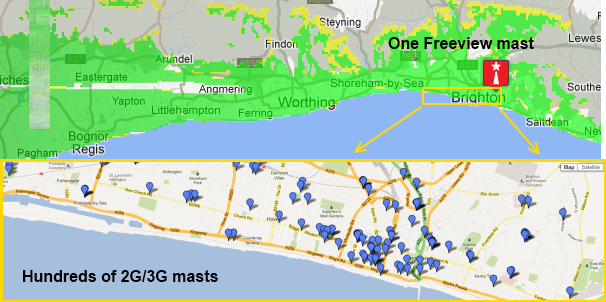800MHz 4G broadband potential for Freeview interference - new map
 Brian Butterworth published on UK Free TV
Brian Butterworth published on UK Free TV To assist with working out where there will be problems when the 4G mobile broadband services launch, I have created a map showing the transmitter areas where the multiplexes will be using the higher end of the transmission range, channels C52 to C60.
If you are using transmitter with these allocations, it is more likely that you will need to fit a filter. If you have your area in an area with allocations outside this range, it is less likely.
However - the problems will only occur when 4G 800MHz services start, and then only if you are close to a mast. See How do I know if the 4G broadband will overload my Freeview?. Being close to a TV transmitter may help. Click on the map to see the full interactive version.

 number of multiplexes in C52-C60 range when 4G 800MHz services start
number of multiplexes in C52-C60 range when 4G 800MHz services start  Retune only
Retune only
When the 4G action is complete, we will have a clearer idea of the locations that will require a filter fitting.
8:23 PM
Stuart Owens: C52 to C60 at present is used only for Freeview. However this frequency range is seen as being possibly at risk of interference from 4G signals using the C61 to C69 range. C60 being the most likely frequency to be affected (and C52 least likely), but this is particularly in areas where there is a strong 4G signal and a weak Freeview signal, where amplification is used and is more likely to be a problem if the 4G signal is coming from the same direction as a weak Freeview signal, where the Freeview signal is vertically polarised and where poor quality coax is used for the downlead or fly leads. The frequency range C49 to C60 could possibly be cleared in the future for 4G/5G use, in which case Freeview would move to lower frequencies and a new range of frequencies would then be potentially at risk from interference, chiefly C39 to C48. Regarding your last point, there are many radio and TV masts that also carry mobile phone antennae. Where masts are shared the likelyhood is that interference will be less of a problem as the Freeview signal would normally be stronger than the 4G signal in the target area.
| link to this comment |
Stuart Owens: Just to add to the above, the issue is also that digital TV receivers with superheterodyne circuits suffer from the N+9 problem - there is a distinct interfere problem nine 8MHz channels away - so C52, C53, C54 and C55 are *MORE* likely to have problems.
| link to this comment |
TV masts are not normally used for 2G/3G services, as they are not really in suitable locations. Here's the Brighton and Hove comparison of sites as an example:

| link to this comment |
ian from notts: Yes, you will need to know where the masts are.
But we won't know this until the capacity is won and the winners select their locations.
| link to this comment |
11:44 PM
My partner today received a postcard from Digital Mobile Spectrum Limited advising her that our Freeview TV service may soon be subjected to 4G interference.
I find it quite unacceptable that legitimate television viewers, who have paid for their licence fee in full, should be inconvenienced in this way. Surely both Ofcom and the BBC have a statutory duty to ensure that this part of the spectrum that is reserved for public broadcasting remains free from unwanted interference.
The recent spectrum auction raised a considerable amount of money that should be used to solve the problem without the need to install filters in millions of homes across the UK. Given the current advice about probable signal overloading at mastheads, the issue also raises huge safety concerns about potentially excessive power levels that are required to service the new 4G networks. Grateful if you could advise whether a full risk assessment has been conducted and, if so, where this can be viewed by members of the public.
Please can someone advise why contact was made with my partner who does not hold a tv licence and is ex-directory rather than the listed licence holder at my address.
Thank you
| link to this comment |
7:43 AM
Nottingham
Dave Randles- this is an independent site mate and does not hold the info for tv licencee holders,
as we speak (as such) areas of birmingham and london are being used as test areas for the introduction of 4G to see what levels of interference they have to deal with.
the sale of the spectrum included conditions on the phone companys to ensure tv viewing disruptions were dealt with, this includes the essential fitting of filters to block unwanted signals
| link to this comment |
ian's: mapI's Freeview map terrainI's terrain plot wavesI's frequency data I's Freeview Detailed Coverage